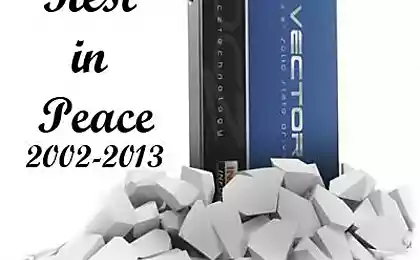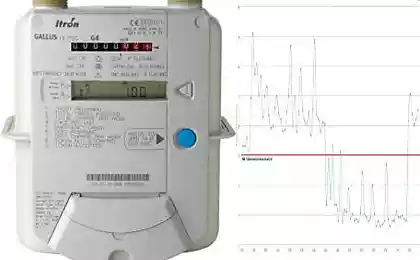1077
OCZ ZD-XL SQL Accelerator. Enlarge your SQL
gave birth to the queen of the night
Not the son, not a daughter;
Not a mouse, not a frog,
A little creatures unknown. I>
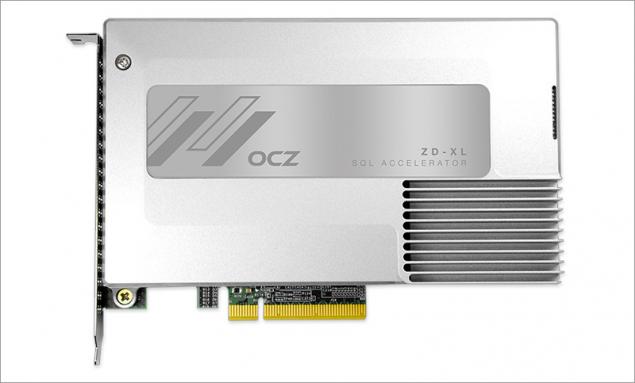
Alexander Pushkin, if he had lived in our time and worked in the IT-industry, that's what would have announced a new version of the device with a beautiful name OCZ ZD-XL SQL Accelerator
In fact, the company's engineers OCZ Storage Soultions have done a great job at getting the product to market. It should be understood that the niche in which it is aimed - a potentially huge, and getting into the client - 100%.
On Softpedia level - is SSD-drive OCZ Z-Drive 4500 (which has long been known to users), with minor modifications, and at the program level - is a host-based application that is able to simultaneously accelerate volume or individual database SQL, located on the block of disk storage, by caching all or part of the SQL database directly on the server side furthermore in the vicinity of the CPU and the RAM bus PCIe.
Let's nyrnёm deeper. Iron parts, as I said, is similar to the PCIe SSD OCZ Z-Drive 4500 - on the drive capacitors are wired to prevent data loss during a power failure. In the drive controller uses 8 SandForce SF-2500 series. Minimum resource MLC-NAND memory is 680 TB for 800GB model, 1300 model TB 1600GB and 3200GB for 2500TB model.
By the way, when buying such units, the company OCZ warranty in addition to offering a dedicated customer support engineer for the entire warranty period.
What is interesting is proposed database admins? After installing the drive and software, special assistant to propose to divide the drive into two parts - one for volume, and the second for the cache. This separation is possible due to two processors visualization located on the drive and control the distribution of NAND, the workload of each controller NAND. This allows you to put on a volume TempDB, and sometimes logs that significantly optimiziret performance SQL-server, reduces network traffic and load on SAN disk storage. Also, when you set up will be given a choice of a method for optimizing cache policies - between the OLAP abbr> (for complex analytical applications) and OLTP abbr> (small discrete transactions).
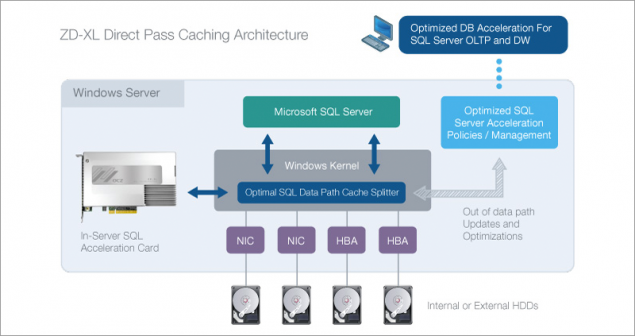
The software allows to set analysis parameters and intervals for each base volume, or under acceleration ZD-XL, which will monitor the activity within a predetermined period of time, and accumulate the statistics for most "hot" data, which can subsequently be loaded into the cache by demand for specialized, regular operations, such as data mining or construction of periodic reports. The function of the pre-filling the cache based on statistics or complete transfer of the volume or database cache, you can quickly bring the system to maximum performance after a reboot or perform specific database operations. Scripting support makes it possible to fully automate these processes.
The administrator can place an entire volume or base, comparable in volume in the cache, and then get a very significant increase and there is no need to pre-analyze that. The procedure is very useful reboots the server, since then synchronize the data in the cache and storage system may be compromised.
Corporate market is significantly different from konsyumerskogo that cheat corporate client is very difficult. Any statements about the performance significantly checked more carefully than end users.
Let's talk about performance. Probably the easiest option - is to compare disk array RAID 6 of 16 SAS-ROM drive with a speed of 10K and two ways of using ZD-XL SQL - how to cache and how to flash.
The picture is the following:
When working with a small number of users - the difference is barely noticeable, but as soon as the border of 5,000 members passed, the gap begins to rise sharply. Server performance (transactions per second) when working with a database of 20,000 users grows up to 2, 5 times at work OCZ ZD-XL SQL as the cache and up to 9 times while working as a data store.
The average waiting time at work the same number of users by using cache improves almost 3 times and a huge amount of time (the difference reaches 6 orders of magnitude) with full room database into memory
And above is not considered the worst options, where the storage system have a direct connection. In cases where consolidation is applied, widely used SAN, the total storage is overloaded itself SAN network is overloaded, the gain from the use of SQL Server ZD-XL can be up to 20 times, with a breath of "fresh air" is produced and the rest of the web server, as traffic is significantly reduced by SQL-Server.

The advantage of this solution is that one can use both the script and the cache and flash - major difference from other similar devices.
Pure performance for connoisseurs:
» With simultaneous reading of 4K blocks in 16 threads and a depth of 16 requests to read the indicators exceed 171K IOPS, write - over 140K IOPS.
» Sequential read / write blocks of 128K is more than 2150 and 1120 gigabytes per second, respectively.
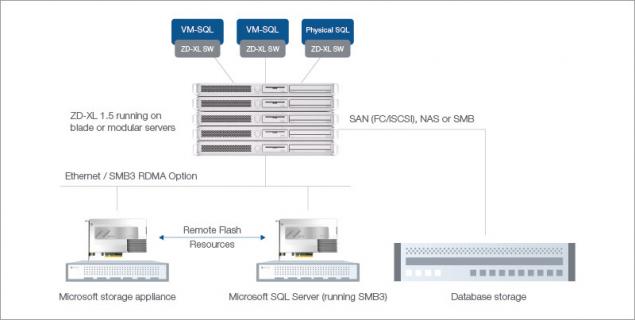
Why am I telling you all this? Yes, in fact, boasts that the company can OCZ - is the solution for a broad segment of the market out of the box, does not require a radical reconfiguration or reconfiguration of the existing system, with instant results, which manifests itself as much as possible of experience in developing simple to use, however, difficult in essence and quality products.
Really unique union of hardware and software already works in real life and will only improve its performance over time. Small drives (800 GB) in a series ZD-XL should be primarily used as a cache, but Big Brother 1, 6, 3, 2 terabytes, of course, to better serve the fast storage for medium-sized databases, parallel accelerating as more cache three-dimensional network resources.
ZD-XL can not only speed up the database in MS SQL, and MS Exchange server, and almost any similar OLTP workload. Simply maximum optimization cache policies implemented for MS SQL.
Given the fact that the deployment does not require special skills and is highly configurable, ZD-XL - an excellent option for accelerating the already existing database servers, which turn on classic hard drives. And the ability to have that cache on one device will be especially useful to speed servers 1C.
To learn more about the product official website . And on this page you can order white paper .
Our previous publications:
» company plans to issue new OCZ SSD 2015
» SSD SATA vs. SSD PCI-E | Part I: theoretical
» OCZ. We returned
Thank you for your attention!
Source: geektimes.ru/company/ocz/blog/245464/
Not the son, not a daughter;
Not a mouse, not a frog,
A little creatures unknown. I>

Alexander Pushkin, if he had lived in our time and worked in the IT-industry, that's what would have announced a new version of the device with a beautiful name OCZ ZD-XL SQL Accelerator
In fact, the company's engineers OCZ Storage Soultions have done a great job at getting the product to market. It should be understood that the niche in which it is aimed - a potentially huge, and getting into the client - 100%.
On Softpedia level - is SSD-drive OCZ Z-Drive 4500 (which has long been known to users), with minor modifications, and at the program level - is a host-based application that is able to simultaneously accelerate volume or individual database SQL, located on the block of disk storage, by caching all or part of the SQL database directly on the server side furthermore in the vicinity of the CPU and the RAM bus PCIe.
Let's nyrnёm deeper. Iron parts, as I said, is similar to the PCIe SSD OCZ Z-Drive 4500 - on the drive capacitors are wired to prevent data loss during a power failure. In the drive controller uses 8 SandForce SF-2500 series. Minimum resource MLC-NAND memory is 680 TB for 800GB model, 1300 model TB 1600GB and 3200GB for 2500TB model.
By the way, when buying such units, the company OCZ warranty in addition to offering a dedicated customer support engineer for the entire warranty period.
What is interesting is proposed database admins? After installing the drive and software, special assistant to propose to divide the drive into two parts - one for volume, and the second for the cache. This separation is possible due to two processors visualization located on the drive and control the distribution of NAND, the workload of each controller NAND. This allows you to put on a volume TempDB, and sometimes logs that significantly optimiziret performance SQL-server, reduces network traffic and load on SAN disk storage. Also, when you set up will be given a choice of a method for optimizing cache policies - between the OLAP abbr> (for complex analytical applications) and OLTP abbr> (small discrete transactions).

The software allows to set analysis parameters and intervals for each base volume, or under acceleration ZD-XL, which will monitor the activity within a predetermined period of time, and accumulate the statistics for most "hot" data, which can subsequently be loaded into the cache by demand for specialized, regular operations, such as data mining or construction of periodic reports. The function of the pre-filling the cache based on statistics or complete transfer of the volume or database cache, you can quickly bring the system to maximum performance after a reboot or perform specific database operations. Scripting support makes it possible to fully automate these processes.
The administrator can place an entire volume or base, comparable in volume in the cache, and then get a very significant increase and there is no need to pre-analyze that. The procedure is very useful reboots the server, since then synchronize the data in the cache and storage system may be compromised.
Corporate market is significantly different from konsyumerskogo that cheat corporate client is very difficult. Any statements about the performance significantly checked more carefully than end users.
Let's talk about performance. Probably the easiest option - is to compare disk array RAID 6 of 16 SAS-ROM drive with a speed of 10K and two ways of using ZD-XL SQL - how to cache and how to flash.
The picture is the following:
When working with a small number of users - the difference is barely noticeable, but as soon as the border of 5,000 members passed, the gap begins to rise sharply. Server performance (transactions per second) when working with a database of 20,000 users grows up to 2, 5 times at work OCZ ZD-XL SQL as the cache and up to 9 times while working as a data store.
The average waiting time at work the same number of users by using cache improves almost 3 times and a huge amount of time (the difference reaches 6 orders of magnitude) with full room database into memory
And above is not considered the worst options, where the storage system have a direct connection. In cases where consolidation is applied, widely used SAN, the total storage is overloaded itself SAN network is overloaded, the gain from the use of SQL Server ZD-XL can be up to 20 times, with a breath of "fresh air" is produced and the rest of the web server, as traffic is significantly reduced by SQL-Server.

The advantage of this solution is that one can use both the script and the cache and flash - major difference from other similar devices.
Pure performance for connoisseurs:
» With simultaneous reading of 4K blocks in 16 threads and a depth of 16 requests to read the indicators exceed 171K IOPS, write - over 140K IOPS.
» Sequential read / write blocks of 128K is more than 2150 and 1120 gigabytes per second, respectively.

Why am I telling you all this? Yes, in fact, boasts that the company can OCZ - is the solution for a broad segment of the market out of the box, does not require a radical reconfiguration or reconfiguration of the existing system, with instant results, which manifests itself as much as possible of experience in developing simple to use, however, difficult in essence and quality products.
Really unique union of hardware and software already works in real life and will only improve its performance over time. Small drives (800 GB) in a series ZD-XL should be primarily used as a cache, but Big Brother 1, 6, 3, 2 terabytes, of course, to better serve the fast storage for medium-sized databases, parallel accelerating as more cache three-dimensional network resources.
ZD-XL can not only speed up the database in MS SQL, and MS Exchange server, and almost any similar OLTP workload. Simply maximum optimization cache policies implemented for MS SQL.
Given the fact that the deployment does not require special skills and is highly configurable, ZD-XL - an excellent option for accelerating the already existing database servers, which turn on classic hard drives. And the ability to have that cache on one device will be especially useful to speed servers 1C.
To learn more about the product official website . And on this page you can order white paper .
Our previous publications:
» company plans to issue new OCZ SSD 2015
» SSD SATA vs. SSD PCI-E | Part I: theoretical
» OCZ. We returned
Thank you for your attention!
Source: geektimes.ru/company/ocz/blog/245464/
RadioShack filed for bankruptcy protection
The new head of Google Glass wants to start a project from scratch

